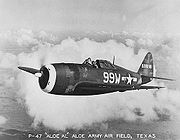
Aloe Army Airfield
Encyclopedia


Victoria, Texas
Victoria is a city in and the seat of Victoria County, Texas, United States. The population was 60,603 at the 2000 census. The three counties of the Victoria Metropolitan Statistical Area had a population of 111,163 at the 2000 census,...
.
History
Aloe AAF was established by the United States Army Air ForcesUnited States Army Air Forces
The United States Army Air Forces was the military aviation arm of the United States of America during and immediately after World War II, and the direct predecessor of the United States Air Force....
as an advanced flying school, first known as Victoria Field #2 on 28 July 1942. It was redesignated as Aloe Army Airfield on 27 October 1942.
Its mission was an advanced single-engine training field for fighter pilots. Aloe also became the new home of the Lake Charles Army Flying School, which relocated from Lake Charles
Lake Charles, Louisiana
Lake Charles is the fifth-largest incorporated city in the U.S. state of Louisiana, located on Lake Charles, Prien Lake, and the Calcasieu River. Located in Calcasieu Parish, a major cultural, industrial, and educational center in the southwest region of the state, and one of the most important in...
, Louisiana
Louisiana
Louisiana is a state located in the southern region of the United States of America. Its capital is Baton Rouge and largest city is New Orleans. Louisiana is the only state in the U.S. with political subdivisions termed parishes, which are local governments equivalent to counties...
.
Its training unit was the 347th Aviation Squadron, which used the North American AT-6 Texan, Curtiss P-40 Warhawk and lastly Republic P-47 Thunderbolt
P-47 Thunderbolt
Republic Aviation's P-47 Thunderbolt, also known as the "Jug", was the largest, heaviest, and most expensive fighter aircraft in history to be powered by a single reciprocating engine. It was heavily armed with eight .50-caliber machine guns, four per wing. When fully loaded, the P-47 weighed up to...
s. Cadets were schooled in flying & in ground & aerial gunnery. During its use as a training airfield, Aloe had a total of 4 satellite fields:
- Aloe Aux #7 (7.6 miles northwest of Victoria), of which no trace remains,
- Aloe Aux #8 (4.2 miles south of Goliad), of which no trace remains,
- Aloe Aux #9 (15 miles southwest of Victoria), of which no trace remains,
- Fannin Aux #10 (7.2 miles ENE of Goliad).
Aloe AAF was inactivated on 31 October 1945, and the government made plans to reassign the field as a subpost of Foster Army Air Field
Foster Air Force Base
Foster Air Force Base is a former United States Air Force base, located approximately east-northeast of Victoria, Texas. A flying training airfield during World War II, it was part of Tactical Air Command during the Cold War as a tactical fighter and command base.-History:Named in memory of Lt....
near Victoria, but both Aloe & Foster were closed. Aloe AAF was declared surplus by the War Department in 1946 and was turned over to the War Assets Administration
War Assets Administration
The War Assets Administration was established in the Office for Emergency Management, effective March 25, 1946, by EO 9689, January 31, 1946. American factorieshad produced massive amounts of weaponry during the World War II...
for disposal.
Aloe Field, with its 304 buildings, was transferred to Victoria County in 1948, after which the site became Victoria County Airport.
In 1960 the County Airport was moved to Foster Field, and Aloe Field was closed. Victoria County returned the field back to the Federal Government in 1961. The base was declared surplus by the General Services Administration in 1962 & offered for sale.
The land was broken into parcels & sold in April 1963. A portion of the former airfield was purchased in 1963 by a local businessman, who leased a runway on a year-to-year basis to the “Rod Benders”, a hot rod club to use the runway for drag races. The club could not make any permanent improvements at the property. They named the facility “Six Flags Drag Way”.
In 1968 G.A. Kupfernagel purchased the property which had been used for drag racing, and named it “Six Flags Raceway Park”. In 1973 Kupfernagel sold the land & equipment. The new owner continued to operate races at the airfield until the end of 1975, when he sold the land to a developer.
The west side of the airfield (including the runways) has become an industrial park. The east side has become a housing development.
See also
- Texas World War II Army AirfieldsTexas World War II Army AirfieldsIn today's United States Air Force, many personnel have spent some of their military service being trained in Texas during World War II. Be it basic military training at Lackland Air Force Base, technical training, officer training, or flight training at other facilities across the state...

